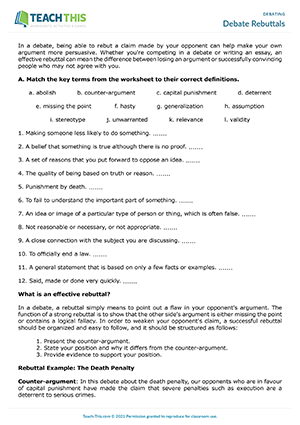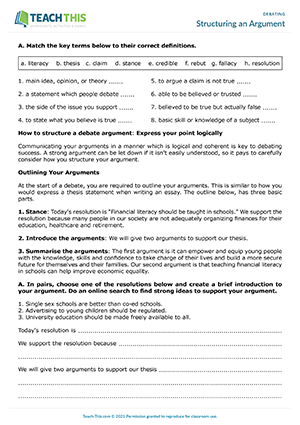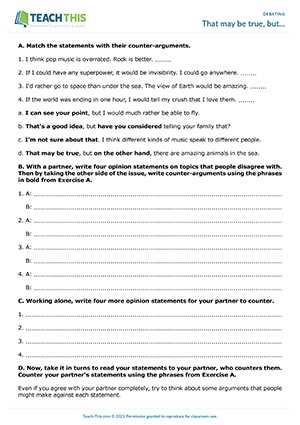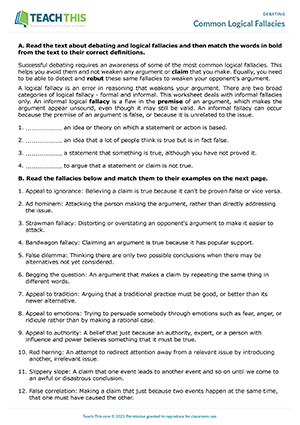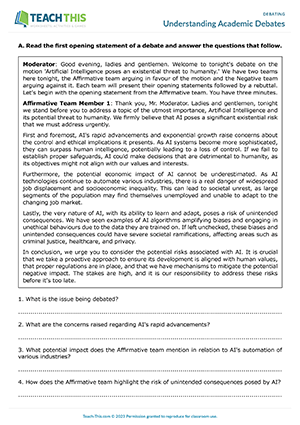In this comprehensive debate rebuttals worksheet, students practice formulating and presenting rebuttals. First, students read a brief introduction to debate rebuttals and match key terms to their correct definitions. Next, students are introduced to the basic structure of a debate rebuttal and are provided with a complete example of a rebuttal that responds to a 'hasty generalization' fallacy. Students then read about two other approaches to creating a rebuttal based on the fallacies of 'red herring' and 'bandwagon'. After that, students write a rebuttal to two counter-arguments following the structure in the example in which they identify the logical fallacy made in the counter-argument. Students then do online research to help them gather support for their arguments. These should include elements of logic, real-world examples, statistics, and quotes from experts or respected publications or institutions. Next, students take it in turns to present their rebuttals. Finally, the class decides which rebuttal was the most persuasive and why.
In this useful structuring an argument worksheet, students learn, practice and present argument outlines and explanations. First, students match key terms from the worksheet with their correct definitions. Next, students read through an explanation and example of an argument outline. In pairs, students then select a resolution and create a brief introduction to their argument using the example argument as a guide. After that, students read through an overview and example of an argument explanation. As with the argument outline, students create their own detailed explanation of their argument following the model provided in the example. Students then use a checklist to review and revise their argument. Finally, students present their argument to other pairs in turn. Each time students present their argument, one student presents the outline of the argument and the other presents the explanation, alternating roles each time. After both arguments have been presented, the pairs decide who presented the most convincing argument and why.
In this productive counter-arguments speaking activity, students practice using partial agreement to counter arguments. First, students match statements with counter-arguments. Next, in pairs, students write four opinion statements on topics that people might disagree with. Students then consider the other side of the issue and write counter-arguments to their opinions. After that, students work individually to write four more opinion statements for their partner to counter. Finally, students take it in turns to read their statements to their partner, who gives a counter-argument using the phrases from the worksheet.
In this free logical fallacies worksheet, students become familiar with 12 common informal logical fallacies and practice identifying them. To begin, students read a short text about debating and logical fallacies and then match key terms from the text to their correct definitions. Next, students read explanations of 12 common logical fallacies and match them to examples. After that, students choose three of the logical fallacies from the list of 12 and create their own examples of each. Finally, in small groups, students take turns sharing one of their examples and the other students try to correctly identify the logical fallacy.
Here is a useful academic debates worksheet that introduces students to the way academic debates are conducted. First, students read the Affirmative team's opening statement addressing the motion, 'Artificial Intelligence poses an existential threat to humanity' and answer questions about it. Next, students read the Negative team's opening statement and answer three multiple-choice questions. Students then read the Affirmative team's rebuttal to the Negative team's opening statement and answer questions with either true, false or not given. Finally, students read the Negative team's rebuttal and decide which of three summaries provided is the best.
Latest Free
Resources
- Everyday Objects Bingo
Everyday Objects
Elementary (A1-A2)
- Action Verb Races
Actions
Elementary (A1-A2)
- Birthday Basics
Birthdays
Elementary (A1-A2)
- Sales Phrasal Verbs
Business Phrasal Verbs
Upper-intermediate (B2)
Latest Member
Resources
- Collocations at Work
Business Collocations
Intermediate (B1)
- Etiquette Trivia Board Game
Etiquette and Manners
Upper-intermediate (B2)
- Everyday Objects Vocabulary
Everyday Objects
Pre-intermediate (A2)
- Let's have a talk
Verb-Noun Collocations
Pre-intermediate (A2)



